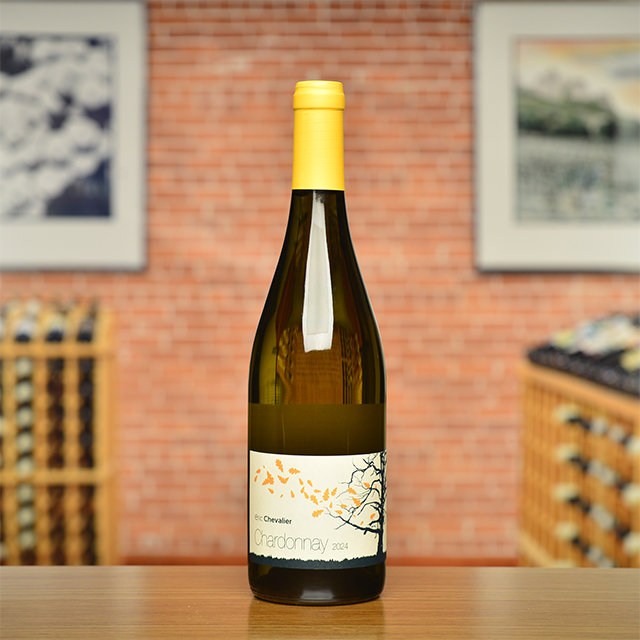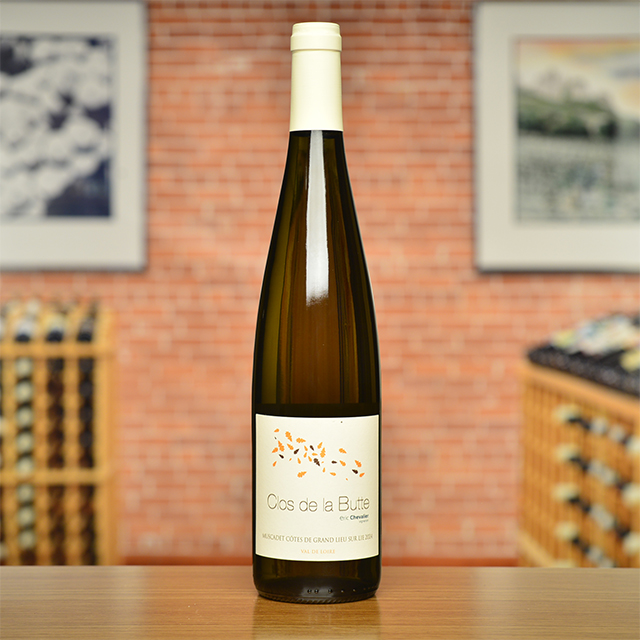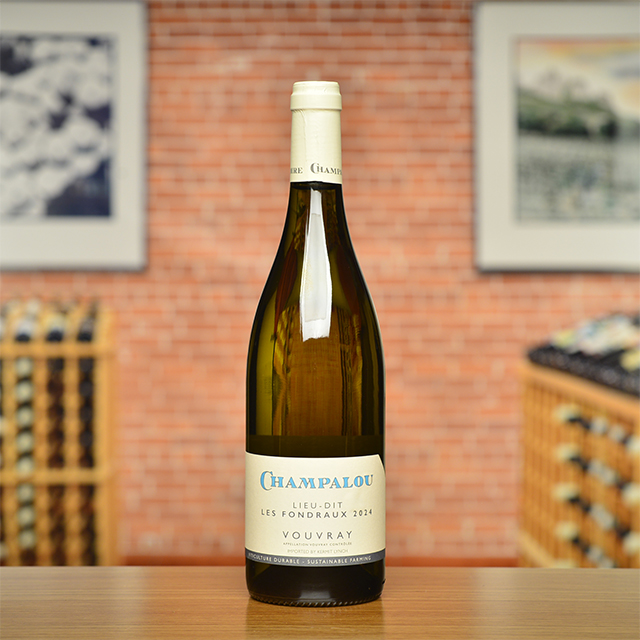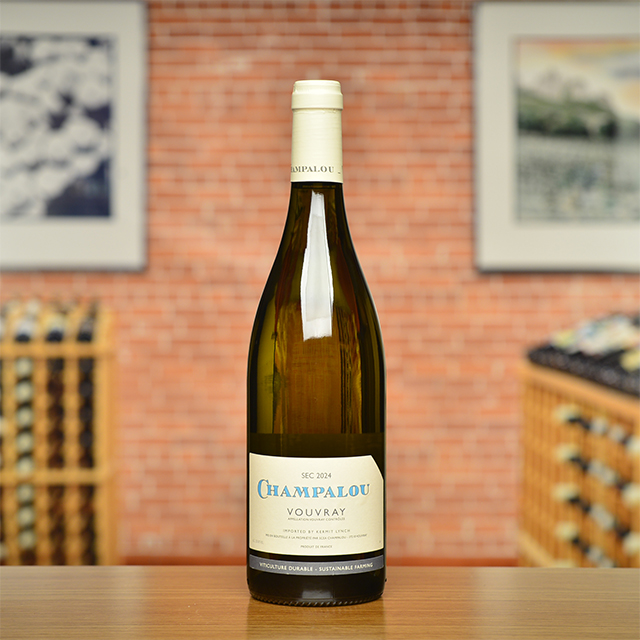Notify me
2018 Vouvray “La Cuvée des Fondraux”
Champalou
Crafting impeccably balanced, off-dry wines like this is no simple task, but the Champalou Fondraux rolls over the tongue so fluidly that you might be tempted to think the berries tasted just like this when they were picked off the vine. It comes down to masterful winemaking, in which precision and savoir faire replace the need for technological intervention to create a velvety, suave Vouvray that oozes class. The contrast of ripe, succulent Chenin Blanc fruit with a spike of flinty minerality is like licking honey off an arrowhead.
—Anthony Lynch
| Wine Type: | white |
| Vintage: | 2018 |
| Bottle Size: | 750mL |
| Blend: | Chenin Blanc |
| Appellation: | Vouvray |
| Country: | France |
| Region: | Loire |
| Producer: | Champalou |
| Winemaker: | Catherine & Didier Champalou |
| Vineyard: | 45 years average, 4 ha |
| Soil: | Clay, Limestone, Flint |
| Farming: | Sustainable |
| Alcohol: | 13% |
More from this Producer or Region

2022 Muscadet Sèvre et Maine “Réserve”
France | Loire
When you smell it, keep in mind that no other wine, besides a Melon de Bourgogne grown in the gabbro soil of Gorges, could possibly smell like this one does.

2020 Vin de France Rouge Grolleau/Cabernet Franc “Clandestine”
France | Loire
A lovely combination of Grolleau Noir and Cabernet Franc, there seems to be a synergistic effect elevating both grapes to create a juicy, spicy, refreshing whole.

2019 Vin de France Rouge Grolleau/Cabernet Franc “Clandestine”
France | Loire
A lovely combination of Grolleau Noir and Cabernet Franc, there seems to be a synergistic effect elevating both grapes to create a juicy, spicy, refreshing whole.

2024 Chardonnay
France | Loire
Some wines deliver well beyond expectations—this is one of them.

2024 Muscadet “Le Clos de la Butte”
France | Loire
** New Wine Added ** This exquisite Muscadet is a perfect reflection of where it originates, as if it’s been sculpted by ocean winds and infused with sea salt.

2024 Bourgueil “Trinch!”
France | Loire
Peppery and bright, earthy and juicy all at once.

2022 Vin de France Rouge “Le Martray”
France | Loire
The new vintage shows great freshness and brightness, making me think of tart berries picked in the forest just a touch below full ripeness.

Vouvray Brut
France | Loire
Made from Chenin Blanc in the Champagne method, this cuvée is the quintessential apéritif sparkling wine, with notes of apple and pear and a fine bead.

2024 Vouvray “Les Fondraux”
France | Loire
The contrast of ripe, succulent Chenin Blanc fruit with a spike of flinty minerality is like licking honey off an arrowhead.

2024 Vouvray
France | Loire
Gentle and refreshing on the palate, it boasts a delightful balance of stony minerality with luscious, almost honeyed fruit and flowery notes.
About The Producer
Champalou
About The Region
Loire

The defining feature of the Loire Valley, not surprisingly, is the Loire River. As the longest river in France, spanning more than 600 miles, this river connects seemingly disparate wine regions. Why else would Sancerre, with its Kimmeridgian limestone terroir be connected to Muscadet, an appellation that is 250 miles away?
Secondary in relevance to the historical, climatic, environmental, and cultural importance of the river are the wines and châteaux of the Jardin de la France. The kings and nobility of France built many hundreds of châteaux in the Loire but wine preceded the arrival of the noblesse and has since out-lived them as well.
Diversity abounds in the Loire. The aforementioned Kimmeridgian limestone of Sancerre is also found in Chablis. Chinon, Bourgueil, and Saumur boast the presence of tuffeau, a type of limestone unique to the Loire that has a yellowish tinge and a chalky texture. Savennières has schist, while Muscadet has volcanic, granite, and serpentinite based soils. In addition to geologic diversity, many, grape varieties are grown there too: Cabernet Franc, Chenin Blanc, Sauvignon Blanc, and Melon de Bourgogne are most prevalent, but (to name a few) Pinot Gris, Grolleau, Pinot Noir, Pineau d’Aunis, and Folle Blanche are also planted. These myriad of viticultural influences leads to the high quality production of every type of wine: red, white, rosé, sparkling, and dessert.
Like the Rhône and Provence, some of Kermit’s first imports came from the Loire, most notably the wines of Charles Joguet and Château d’Epiré—two producers who are featured in Kermit’s book Adventures on the Wine Route and with whom we still work today.
More from Loire or France
2018 Saumur Blanc “L’Échelier”
Thierry Germain France | Loire
2023 Chinon “Les Petites Roches”
Charles Joguet France | Loire
2024 Chinon “Les Granges”
Bernard Baudry France | Loire
Vouvray Brut
Champalou France | Loire
2023 Bourgueil “Cuvée Alouettes”
Domaine de la Chanteleuserie France | Loire
2023 Savennières
Château d’Epiré France | Loire
2024 Coteaux du Loir Blanc
Pascal Janvier France | Loire
2021 Bourgueil “La Dilettante”
Catherine & Pierre Breton France | Loire
2023 Chinon “Le Domaine”
Bernard Baudry France | Loire
2021 Vin de France Blanche
Domaine Michel Brégeon France | Loire
2024 Bourgueil “Cuvée Alouettes”
Domaine de la Chanteleuserie France | Loire
2022 Chinon “Cuvée Terroir”
Charles Joguet France | Loire
2018 Saumur Blanc “L’Échelier”
Thierry Germain France | Loire
2023 Chinon “Les Petites Roches”
Charles Joguet France | Loire
2024 Chinon “Les Granges”
Bernard Baudry France | Loire
Vouvray Brut
Champalou France | Loire
2023 Bourgueil “Cuvée Alouettes”
Domaine de la Chanteleuserie France | Loire
2023 Savennières
Château d’Epiré France | Loire
2024 Coteaux du Loir Blanc
Pascal Janvier France | Loire
2021 Bourgueil “La Dilettante”
Catherine & Pierre Breton France | Loire
2023 Chinon “Le Domaine”
Bernard Baudry France | Loire
2021 Vin de France Blanche
Domaine Michel Brégeon France | Loire
2024 Bourgueil “Cuvée Alouettes”
Domaine de la Chanteleuserie France | Loire
2022 Chinon “Cuvée Terroir”
Charles Joguet France | Loire
Where the newsletter started

Where the newsletter started
Every three or four months I would send my clients a cheaply made list of my inventory, but it began to dawn on me that business did not pick up afterwards. It occurred to me that my clientele might not know what Château Grillet is, either. One month in 1974 I had an especially esoteric collection of wines arriving, so I decided to put a short explanation about each wine into my price list, to try and let my clients know what to expect when they uncorked a bottle. The day after I mailed that brochure, people showed up at the shop, and that is how these little propaganda pieces for fine wine were born.—Kermit Lynch
















